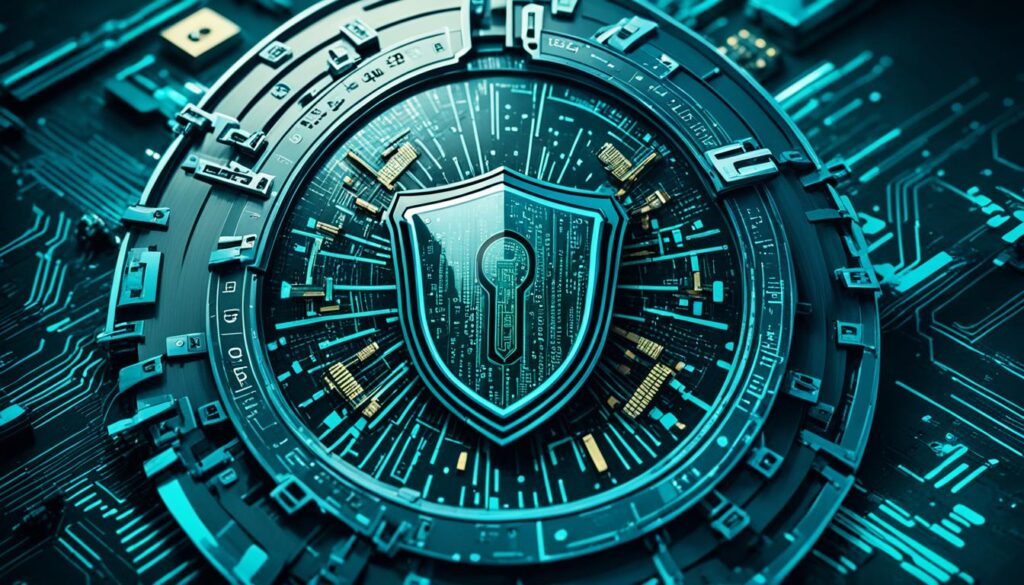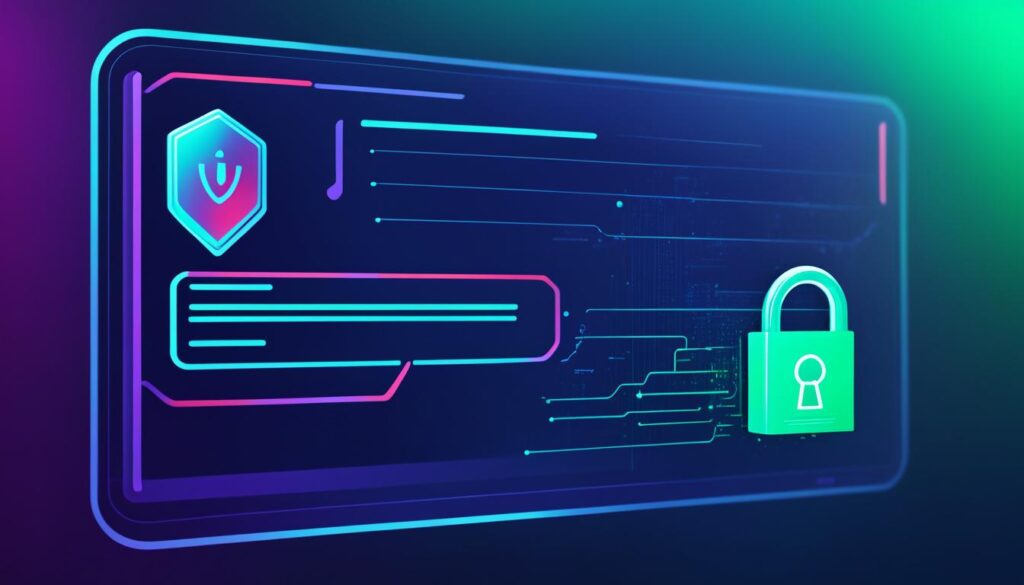In a staggering revelation, Gartner reports that cybersecurity breaches have vaulted code signing into the spotlight, with a predicted growth rate in adoption by secure software development teams expected to exceed 30% annually. Riding the cusp of this exponential demand is the future of code signing—an unseen, yet fundamental, fortress against cyber threats, affirming software authenticity and user safety in our interconnected world.
The necessity for trusted code signing illuminates the path ahead for developers and enterprises alike. It stands as the guardian of digital trust, ensuring that every piece of code reaching your devices remains untainted from the source to execution. In a world leaning towards zero-trust frameworks, the secure handshake between developer intentions and end-user expectations has never been more profound.
Key Takeaways
- The surging trend of trusted code signing as a standard in software security.
- The pivotal role of code signing in preserving digital trust within zero-trust environments.
- Anticipated advancements mark the future of code signing, evolving with growing cyber threat landscapes.
- Code signing practices are essential to building integrity in secure software development workflows.
- The adoption of code signing as a proactive defense mechanism against potential breaches in software distribution.
- Digital signatures as the cornerstone of maintaining code sanctity and confirming authorship.
Understanding Code Signing in the Zero-Trust World
The digital world is advancing at an exponential rate, and with it, the need for robust software security measures has become paramount. In the fabric of a zero-trust security model, every operation and access request is suspicious until proven otherwise. Here is where the role of code signing becomes critical in maintaining the integrity and trustworthiness of software systems.
What is Code Signing?
At its core, code signing is the process of affixing digital signatures to software, applications, and scripts. This acts as a digital seal of authenticity, assuring the end-user that the signed code has been verified and is untampered since its original issuance. By using cryptographic algorithms, it provides a secure layer of confidence for distributors and consumers alike, ensuring that the code they execute originates from a known and trusted source.

Why Code Signing is Essential for Software Security
In an environment where the authenticity of digital assets cannot be taken for granted, code signing certificates serve as virtual passports for software, confirming its legitimacy and safeguarding against malicious tampering. For developers and organizations, these certificates are a fundamental component of software distribution, building a foundation of trust with users.
Let’s delve into how various platforms rely on code signing:
| Platform/Scenario | Importance of Code Signing |
|---|---|
| PowerShell Scripts (MS Windows) | Prevents the execution of unauthorized or modified scripts that could compromise system integrity. |
| Mobile Device Software | Essential for app store submissions and device security, assuring users of the software’s source. |
| Operating System Drivers | Ensures that the drivers are provided by a trusted manufacturer and have not been altered. |
| Java Virtual Machines | Implements security controls to prevent execution of untrusted or compromised Java code. |
| Open-Source Archives | Protects the integrity of open-source software, confirming the authenticity of community-contributed code. |
| POS Terminals | Secures high-value transaction devices against unauthorized access or fraudulent software updates. |
This table highlights the diverse applicability and crucial nature of code signing in reinforcing software security. The implementation of digital signatures through code signing certificates is not just a technical formality but a mandatory practice to instill trust and integrity in the zero-trust paradigm.
The Future of Code Signing
The digital landscape is on the precipice of substantial change, especially in the domain of code signing. With innovations in code signing rapidly emerging, stakeholders within the industry are geared towards enhancing the security and trustworthiness of software. The recent advancements point toward a more sophisticated future, where the practice of code signing is not just a formality, but a strategic imperative for secure software development.
In light of the continuous threats faced by the digital ecosystem, the call for advancements in trusted code signing is becoming more pronounced. Enterprises are seeking to implement new technologies and methodologies to upscale the security fabric that safeguards their products. These developments are not merely reactive measures but are being designed to anticipate and neutralize threats proactively.
Industry thought leaders believe that the next revolution in code signing will pivot around integrating additional layers of verification and automated mechanisms, fostering a more resilient barrier against code tampering and cyber threats.
- Enhanced validation techniques for verifying code authenticity
- Increased use of multi-factor authentication to secure code signing keys
- Automation in the code signing process to reduce human error and improve efficiency
- Integration of Artificial Intelligence and Machine Learning for anomaly detection in code alterations
The narrative of code signing is being rewritten with these innovations, charting a path towards a future where trust and security are paramount. The evolution is not only technical but conceptual, with a growing understanding that trusted code signing is a cornerstone of modern cyberdefence strategies.

As this arena matures, industry leaders, developers, and security professionals alike will continue to observe and adapt to these ever-changing innovations. In sum, the future of code signing represents a significant stride in the collective effort to fortify and instil confidence in the integrity of software systems.
Code Signing Technologies: Today and Tomorrow
As we delve into the fabric of modern cybersecurity, the significance of code signing technologies becomes ever more apparent. These technologies are crucial to the framework of secure software development, and play a vital role in ensuring the authenticity and integrity of digital content. Today, code signing is shaped by established principles, but as we turn our gaze forward, a host of promising innovations appear on the horizon.

Current State of Code Signing Technologies
The backbone of today’s code signing comprises a sophisticated Public Key Infrastructure (PKI), rooted in combining private and public keys with verified organizational identification through digital certificates. This intricate mechanism ensures that software creators can firmly attest to their work’s security and validity. Organizations typically rely on two robust forms of code signing certificates: Organization Validation (OV) and Extended Validation (EV). Each type offers a tailored approach to security, designed to meet varying assurance levels and security needs.
Emerging Innovations in Code Signing
Peering into the future, we see the advent of new features destined to revolutionize code signing. Innovations expected to redefine the landscape include:
- Two-factor authentication, adding an additional safeguard against unauthorized access,
- Timestamping services to extend the lifespan of a code’s trustworthiness, and
- Greater integration with hardware security modules (HSMs) for fortified key protection.
These advancements are set to elevate the trustworthiness of code and fortify the walls of cybersecurity.
| Technology | Description | Impact on Security |
|---|---|---|
| Two-factor Authentication | A security process which requires two different authentication factors to verify user identity. | Greatly enhances protection against unauthorized code manipulation. |
| Timestamping | A process that proves the code was signed before the certificate expiration. | Ensures code validity for long-term use, even after certificates expire. |
| Integration with HSMs | Using dedicated hardware to manage and store cryptographic keys. | Provides superior security for signing keys, minimizing the risk of exposure or compromise. |
The Evolution of Trusted Code Signing Practices
As the digital landscape continues to evolve, so does the importance of implementing trusted code signing methodologies. Secure code signing is a fundamental aspect of software security, ensuring that the integrity and origin of code are verifiable. Keeping abreast of code signing best practices is not only recommended but necessary for organizations aiming to maintain the trust of their users and protect their systems from malicious intent.
Best Practices for Secure Code Signing
To secure the integrity of software and scripts, it’s imperative for developers and organizations to adopt robust code signing best practices. This starts with secure key issuance and spans to comprehensive protocols for key storage. By implementing such practices, the industry can better ensure that code remains free from tampering and that digital trust is upheld.
Here are some pivotal best practices:
- Utilize Hardware Security Modules (HSMs) to store private keys securely.
- Enforce multi-factor authentication to mitigate unauthorized access to keys.
- Define clear-cut roles and responsibilities around who can issue and handle keys.
- Ensure all coding scripts are time-stamped to maintain validity even after certificate expiration.
- Regularly audit and update signing protocols to counteract evolving security threats.

How Organizations are Adapting to Trusted Code Signing
Transitioning to trusted code signing practices is an ongoing process that demands diligence and adaptability from organizations. Clear policies regarding key usage and a staunch approach to preventing key sharing are integral to modern code-signing protocols. This helps to substantially reduce the risk of key mismanagement or compromise, fortifying an organization’s defenses against cyber threats.
| Code Signing Practice | Benefits | Implementation Method |
|---|---|---|
| Hardware Security Module (HSM) | Enhanced security for key storage | Procure and integrate HSM within signing infrastructure |
| Multi-factor Authentication | Reduces unauthorized access to keys | Implement authentication mechanisms such as OTPs, biometrics |
| Delineated Roles and Responsibilities | Minimizes human error and clear accountability | Create a hierarchical approach to access control |
| Time-stamped Scripts | Ensures code validity beyond certificate expiration | Use time-stamping services compliant with industry standards |
| Audits and Protocol Updates | Keeps security measures up to date | Schedule regular security reviews and updates |
By investing in these practices, organizations reassure stakeholders of their commitment to security and trust, laying a solid foundation in an era where software integrity is paramount. This evolution contributes to a safer software ecosystem and encourages continuous improvement in code signing protocols.
The Role of Digital Signatures in Secure Software Development
In the realm of secure software development, digital signatures play a pivotal role by fortifying the veracity and security of electronic documents and code. Their function extends beyond simple authentication, encompassing critical aspects of non-repudiation and integrity. As new technologies unfurl, digital signatures remain at the heart of innovation, blending seamlessly with cutting-edge solutions such as blockchain.

The advent of blockchain technology brings with it an unalterable ledger system, which when combined with digital signatures, enhances the overall security landscape. This synergistic relationship underscores the commitment to maintain a robust protection of software against any unauthorized tampering. Moreover, the synergy of digital signatures with AI and mobile-first methodologies underscores the industry’s drive towards a landscape where efficacy merges with user-centric security considerations.
- Authenticity Assurance: Digital signatures bind the signer’s identity with the document or code, making it easy to authenticate origin and consent.
- Integrity Verification: Any alteration made to the signed content after the time of signing is detectable, ensuring the code remains uncorrupted.
- Non-repudiation: Signers cannot feasibly deny their signature, providing a layer of accountability and trust within the digital space.
As we embrace the new era of digital solutions in 2023, developers and organizations alike continue to leverage the power of digital signatures in secure software development. This not only aligns with best practices in cybersecurity but also anticipates the evolving needs and expectations of a modern, security-conscious user base.
| Technology | Role of Digital Signatures | Impact on Security |
|---|---|---|
| Blockchain | Digital signatures validate transactions and smart contracts. | Enhances trust with an immutable record of transactions. |
| Artificial Intelligence (AI) | Ensure the authenticity of AI operations and decisions. | Introduces accountability and traceability to AI systems. |
| Mobile Technologies | Secures app distributions and mobile payment systems. | Improves user trust and supports secure mobile ecosystems. |
Proliferation of Code Signing Certificates
The digital landscape has seen an explosive increase in the adoption of code signing certificates, providing essential layers of software security in a myriad of applications. These cryptographic stamps of approval ensure that software delivered to end-users remains untouched and trustworthy from its point of origin to execution.
Distinguishing Between OV and EV Certificates
When it comes to software security, understanding the type of code signing certificate being used is paramount. Organization Validation (OV) certificates offer a level of validation that confirms the identity of the organization responsible for the software, whereas Extended Validation (EV) certificates take this a step further. EV certificates require a comprehensive authentication process that culminates in a universally recognized indicator of trustworthiness — a green address bar in browsers that display the verified company name.
How Code Signing Certificates Strengthen Trust
Code signing certificates are more than just digital seals; they’re fundamental components that foster trust and confidence among software users. These certificates act as a pledge from the developer to the user, attesting to the integrity of the code and the identity of its creator. With an ever-increasing focus on software security, a certified signature is fast becoming a non-negotiable expectation for users when installing new software.
Implementing Code Signing Best Practices in Enterprises
As the digital landscape becomes increasingly complex, code signing best practices and enterprise security are more crucial than ever for businesses looking to protect their assets and brand reputation. Establishing rigorous policies and strategies around key management is at the heart of safeguarding software integrity and maintaining the trust of users and stakeholders.
Policies Ensuring Effective Key Management
Success in effective key management begins with clarity in policy. Organizations should institute comprehensive guidelines that detail every aspect of key handling—from issuance to revocation. This ensures that code signing keys are supervised assiduously and are accessible only to authorized personnel, thus preventing unauthorized use and potential security breaches.
Strategies to Prevent Key Compromise and Misuse
Implementing fail-safe strategies to eliminate the risk of key compromise includes adopting sophisticated tools like Hardware Security Modules (HSMs) that offer fortified storage solutions. Additionally, enterprises must ensure regular compliance checks and security audits, and enforce the principles of segregation of duties to delineate clear boundaries and responsibilities.
| Best Practice | Purpose | Tools/Strategies |
|---|---|---|
| Limited Key Access | Restrict use to authorized individuals | User Access Controls, Authentication Protocols |
| Segregation of Duties | Prevent a single point of failure | Role-based Access Control (RBAC) |
| Regular Security Audits | Continuous oversight and compliance | Audit Trails, Periodic Review Processes |
| Use of HSMs | Enhanced security for key storage | Hardware Security Modules |
| Revocation Policies | Ability to revoke keys when compromised | Certificate Revocation Lists (CRLs), OCSP |
Adherence to these foundational strategies fortifies an enterprise’s defenses against evolving threats, ensuring that their use of digital signatures and code signing certificates remains unassailable and that enterprise security is not compromised.
Emerging Challenges and Solutions in Code Signing
In the digital era, safeguarding software has become paramount, as nefarious elements consistently innovate methods to breach security. Code signing, an indispensable feature for establishing software credibility, is being fortified to withstand the challenges posed by these ever-evolving threats to the supply chain. Strategies are in place to enhance the robustness of code signing, making it a fulcrum for secure software dissemination.
Addressing Supply Chain Threats Through Code Signing
Supply chain threats have proliferated as attackers exploit numerous vectors to insert malicious code into software before it reaches end-users. Companies are responding by implementing stringent code signing procedures, ensuring that every link in the supply chain is secure. These enhanced protocols not only validate the origin of the code but also its integrity from conception to deployment.
The Importance of Time-Stamping in Code Longevity
Time-stamping serves as a keystone in extending the reliability of code signatures. As certificates have a finite lifespan, time-stamping preserves the credibility of digital signatures, maintaining its validity post certification expiration. This is critical for long-lived software, as it assures users of its integrity throughout the software’s operational life cycle.
| Challenge | Impact on Code Signing | Solution |
|---|---|---|
| Complex Supply Chains | Increased risk of interference and code manipulation | End-to-end supply chain control mechanisms including regular audits |
| Certificate Expiration | Potential invalidation of software trustworthiness | Implementation of time-stamping for ongoing validity of signatures |
| Advanced Persistent Threats (APTs) | Prolonged and targeted attacks on software authenticity | Employing multi-layered defense strategies and real-time threat detection |
In conclusion, the fusion of enhanced verification mechanisms with time-stamping ensures the resilience of software against supply chain threats and preserves code signing longevity. As these advanced methods evolve, they will continue to provide a bastion of trust and stability in the dynamic scape of secure software development.
Conclusion
As we forge ahead into an era where trust and security are not just luxuries but necessities, the future of code signing appears both promising and demanding. This digital authentication process, once a mere formality, is now a fundamental aspect of secure software development. With cyber threats evolving at a breakneck pace, the reliance on trusted code signing to maintain the sanctity of our digital infrastructure can hardly be overstated.
Through the diligent application of digital signatures, we not only validate authorship but also ensure the untainted integrity of software. As these practices mature, incorporating novel technologies and stricter verification tactics, developers and enterprises alike must stay abreast of the myriad changes. It’s a commitment that stands to benefit all stakeholders by fostering a secure environment where trust is the currency and innovation does not equate to vulnerability.
Indeed, the tapestry of tomorrow’s digital landscape is interwoven with these enhanced security measures. As we embrace this journey, it becomes increasingly clear that a profound dedication to leading-edge code signing practices will be paramount in cultivating user confidence and safeguarding our digital ecosystem against threats yet unseen. The narrative of code signing is one of continuous adaptation, striving towards a future where software security is ingrained in the very fabric of how we create, distribute, and consume our technological advancements.
FAQ
What is Code Signing?
Code signing is the process of digitally signing executables and scripts to verify the authorship of the software and to ensure that the code has not been altered or compromised after it was issued.
Why is Code Signing Essential for Software Security?
Code signing provides assurance to the end-user that the software is genuine and has not been tampered with. It is integral to maintaining software integrity, particularly in a zero-trust world where verification of every action is crucial to security.
What are the Current Trends in the Future of Code Signing?
The future trends in code signing are moving towards enhanced security measures, such as integrating two-factor authentication and the use of hardware security modules (HSMs), as well as adapting to innovations like blockchain and AI to secure code signing processes.
What is the Current State of Code Signing Technologies?
Today, code signing technologies are heavily reliant on Public Key Infrastructure (PKI), which includes both Organization Validation (OV) and Extended Validation (EV) code signing certificates to assure the identity of the signer and the security of the code.
What Innovations are Emerging in Code Signing?
Innovations in code signing include the integration of multi-factor authentication, more secure timestamping methods, and the potential use of blockchain technology to maintain an immutable ledger of code signatures.
What are the Best Practices for Secure Code Signing?
Best practices include stringent key management, avoiding key sharing, using secure storage such as HSMs, implementing multi-factor authentication, and establishing clear policies for key issuance and revocation.
How are Organizations Adapting to Trusted Code Signing Practices?
Organizations are adapting by creating comprehensive policies that define the issuance and management of keys, incorporating role-based access, and regular auditing to ensure the integrity of the code signing process.
What Role Do Digital Signatures Play in Secure Software Development?
Digital signatures validate the authenticity, integrity, and non-repudiation of software, making them an integral part of secure software development to establish trust and verify code legitimacy.
How Do OV and EV Certificates Differ?
OV certificates provide verified identity assurance for software signing, while EV certificates involve a more extensive verification process and require hardware-based two-factor authentication for an enhanced security level.
How Do Code Signing Certificates Strengthen Trust?
By ensuring the signatory’s identity and the integrity of the software, code signing certificates strengthen trust by giving end-users confidence that the software they are using is secure and authentic.
What Policies Should Enterprises Implement for Effective Key Management?
Enterprises should have detailed policies outlining key issuance, maintenance, revocation procedures, and regular security audits, along with best practices for the secure storage and management of private keys.
What Strategies Can Prevent Key Compromise and Misuse?
Strategies include segregation of duties, restricting key access, mandatory use of HSMs, routine security assessments, and enforcing multi-factor authentication to mitigate risks of key compromise and misuse.
How Can Supply Chain Threats be Addressed Through Code Signing?
Supply chain threats can be mitigated by implementing rigorous code signing protocols, strict verification processes, and by incorporating mechanisms like EV certificates and secure timestamping to maintain trust in the software supply chain.
Why is Time-Stamping Important for Code Longevity?
Time-stamping is critical because it allows a signature to be verified even after the signing certificate has expired. This practice maintains the trustworthiness of the software over time, contributing to its reliability and security.





